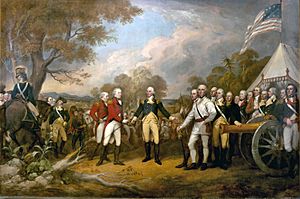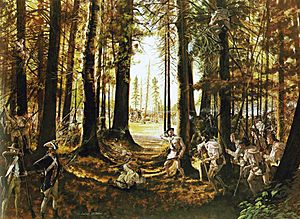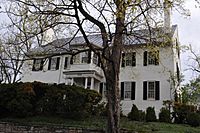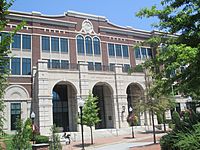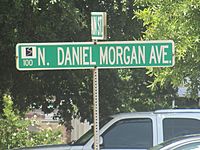Daniel Morgan facts for kids
Quick facts for kids
Daniel Morgan
|
|
|---|---|
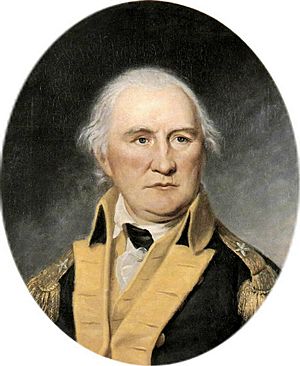 |
|
| Member of the U.S. House of Representatives from Virginia's 1st district |
|
| In office March 4, 1797 – March 5, 1799 |
|
| Preceded by | Robert Rutherford |
| Succeeded by | Robert Page |
| Personal details | |
| Born | 1736 Hunterdon County, Province of New Jersey, British America |
| Died | July 6, 1802 (age 66) Winchester, Virginia, U.S. |
| Resting place | Mount Hebron Cemetery, Winchester, Virginia |
| Political party | Federalist |
| Spouse | Abigail Curry |
| Occupation | Soldier |
| Military service | |
| Allegiance | |
| Branch/service | |
| Years of service | 1775–1783; 1794 |
| Rank | Brigadier General |
| Battles/wars | American Revolutionary War |
Daniel Morgan (1736–July 6, 1802) was an important American soldier and politician from Virginia. He was known as a brilliant battlefield leader during the American Revolutionary War (1775–1783). Later, he also helped stop the Whiskey Rebellion (1791–1794).
Born in New Jersey to Welsh parents, Morgan later moved to Winchester, Virginia. He became an officer in the Virginia militia. When the Revolutionary War began, he quickly formed a company of skilled riflemen. He fought in the expedition to Quebec and the Saratoga campaign. After a short break from the army, he returned to lead the Continental Army to a major victory at the Battle of Cowpens.
After the war, Morgan built a large estate. He was called back to duty in 1794 to help end the Whiskey Rebellion. He was a member of the Federalist Party and was elected to the United States House of Representatives in 1796. He left Congress in 1799 and passed away in 1802.
Contents
Early Life and Adventures
Daniel Morgan was likely born in New Hampton, New Jersey. His grandparents were Welsh immigrants. When he was 17, he left home after an argument with his father. He worked odd jobs in Pennsylvania before moving to the Shenandoah Valley in Virginia. He settled near what is now Winchester, Virginia.
He worked hard, clearing land and running a sawmill. He also worked as a teamster, driving wagons. In just a few years, he saved enough money to buy his own wagons. His business grew quickly. During the French and Indian War, he worked as a civilian teamster. He was once punished severely for arguing with an officer. This made him dislike British authority. Later, when he led his own troops, he made sure no one was flogged. He married Abigail Curry, and they had two daughters. Abigail taught him how to read and write.
Morgan later served as a rifleman protecting western settlements from Native American raids. He helped defend Fort Edwards. By 1774, he was very successful and owned a large farm. That year, he fought in Lord Dunmore's War, raiding Shawnee villages.
Fighting for Freedom: The Revolution
The American Revolutionary War started in April 1775. The Continental Congress formed the Continental Army. They asked for 10 rifle companies from the middle colonies. Virginia agreed to send two. Daniel Morgan was chosen to lead one of these companies.
Morgan quickly recruited 96 men in just 10 days. His company of expert marksmen was called "Morgan's Riflemen". They marched 600 miles (970 km) to Boston, Massachusetts in 21 days. They arrived on August 6, 1775. Their long rifles were very accurate and could shoot much farther than standard muskets. Morgan used his men as snipers, targeting British officers. This made the British very angry.
The Invasion of Canada
In June 1775, the Continental Congress decided to invade Canada. Colonel Benedict Arnold planned an attack on Quebec. General Washington sent three companies from Boston to help. Morgan's company was chosen, and he was picked to lead them.
The Arnold Expedition started with about 1,050 men. By the time they reached Quebec in November, only 675 remained. They joined forces with Montgomery's troops. The Battle of Quebec began on December 31. Arnold's force attacked from the north. Arnold was wounded early in the fight. Morgan took command and led his men into the city.
However, Montgomery's attack failed, and he was killed. British General Carleton then surrounded Morgan's troops. Morgan's men were caught in a trap and had to surrender. Morgan was one of 372 men captured. He remained a prisoner until January 1777.
The 11th Virginia Regiment
When Morgan rejoined Washington's army in 1777, he learned he had been promoted to colonel for his bravery at Quebec. He was ordered to create and lead a new regiment, the 11th Virginia Regiment.
On June 13, 1777, Morgan was given command of the Provisional Rifle Corps. This was a group of 500 riflemen from different states. Washington sent them to bother General William Howe's army as they moved through New Jersey.
The Battle of Saratoga
A part of Morgan's regiment was sent to help General Horatio Gates fight Burgoyne's army. Morgan is shown in the famous painting of the Surrender of General Burgoyne at Saratoga.
Freeman's Farm
Morgan led his regiment ahead of the main American forces. At Freeman's Farm, they met General Simon Fraser's British troops. Morgan's men quickly killed many British officers.
Morgan's men charged, but the attack became disorganized. Benedict Arnold and Morgan managed to regroup the unit. Morgan's riflemen kept firing accurately from the woods, breaking up British formations. More American troops joined them. The Americans held the British back, but British bayonet charges stopped American attacks.
Bemis Heights
Burgoyne's next attack led to the Battle of Bemis Heights on October 7. Morgan commanded the American left side. The British tried to attack this side with 1,500 men. Morgan's brigade again faced General Fraser's forces.
Morgan's sharpshooters trapped the British light infantry in a crossfire. General Fraser tried to rally his men. Benedict Arnold arrived and told Morgan that Fraser needed to be stopped. Morgan reluctantly ordered a sniper to shoot Fraser, and Timothy Murphy did so.
With Fraser badly wounded, the British light infantry retreated. Morgan and Arnold then led a counter-attack. Burgoyne's army lost about 500 men and pulled back. Morgan's men then moved to Burgoyne's north, stopping any British patrols. This convinced the British that they could not escape.
New Jersey and a Break from Service
After Saratoga, Morgan's unit rejoined Washington's main army near Philadelphia. In 1778, he attacked British supply lines in New Jersey. He was not in the Battle of Monmouth but chased the retreating British, capturing many prisoners.
Morgan became unhappy with the army and Congress. He felt he was overlooked for promotion to brigadier general. His legs and back also hurt from his time in Quebec. He was allowed to resign on June 30, 1779, and went home to Winchester.
In June 1780, General Gates asked him to return to service, but Morgan refused. However, after Gates' terrible defeat at the Battle of Camden, Morgan put aside his concerns. He went to join the Southern command.
The Southern Campaign
Morgan met Gates and was given command of the light infantry on October 2. Finally, on October 13, 1780, Morgan was promoted to brigadier general.
Morgan met his new commander, Nathanael Greene, in December 1780. Greene decided to split his army to buy time. He gave Morgan command of about 600 men. Their job was to gather supplies and bother the enemy in South Carolina, but to avoid big battles.
When the British General Cornwallis realized this, he sent Colonel Banastre Tarleton's British Legion to find Morgan. Morgan decided to disobey his orders and set up a direct fight.
The Battle of Cowpens
Morgan chose to fight at Cowpens, South Carolina. On January 17, 1781, they met Tarleton's forces in the Battle of Cowpens. Morgan's army included militia led by Andrew Pickens and William Washington's dragoons.
Morgan's plan used Tarleton's tendency to act quickly and his low opinion of militia. Morgan placed his marksmen in front, then the militia, and the regular soldiers on a hilltop. The first two groups were to fire and then retreat. This would trick the British into charging too soon.
This clever plan led to a "double envelopment," where the American forces surrounded the British. In less than an hour, Tarleton's 1,076 men lost 110 killed and 830 captured. This included 200 wounded. The Americans captured all of Tarleton's supplies. Morgan's plan at Cowpens is considered one of the best military tactics in history.
Cornwallis lost many of his best troops. For his victory, Virginia gave Morgan land and an estate. However, the campaign made his leg and back pain worse. On February 10, he returned to his farm. In July 1781, Morgan briefly joined Lafayette to chase Tarleton again in Virginia, but they did not succeed.
Life After the War
After leaving the army at age 46, Morgan returned home to Frederick County. He focused on investing in land and built a large estate of over 250,000 acres (1,000 km2). In 1782, he joined the Presbyterian Church. He built a new house near Winchester, Virginia, using Hessian prisoners of war. He named his home Saratoga after his victory in New York. In 1790, Congress gave him a gold medal for his victory at Cowpens.
In 1794, he was called back to service to help stop the Whiskey Rebellion. He was promoted to major general. Morgan led part of the army into Western Pennsylvania. This large show of force ended the protests without any fighting. Morgan commanded the remaining troops in Pennsylvania until 1795.
Morgan ran for the U.S. House of Representatives twice as a Federalist. He lost in 1794 but won in 1796. He served one term from 1797 to 1799.
He passed away at his daughter's home in Winchester on July 6, 1802. He was first buried in the Old Stone Presbyterian Church graveyard. After the American Civil War, his body was moved to the Mt. Hebron Cemetery in Winchester, Virginia.
What is Daniel Morgan Remembered For?
Daniel Morgan's great-great-grandfather was also the uncle of the famous Welsh privateer, Henry Morgan.
Many places are named after Daniel Morgan:
- In 1820, Virginia named a new county, Morgan County, in his honor. This county is now in West Virginia.
- Several other states also have counties named Morgan: Alabama, Georgia, Illinois, Indiana, Kentucky, Missouri, Ohio, and Tennessee.
- The city of Morganton in North Carolina is named after him.
- The city of Morganfield, Kentucky, was founded in 1811 on land that was part of a Revolutionary War grant to Daniel Morgan.
In 1881, a statue of Morgan was placed in the main town square of Spartanburg, South Carolina. It is still there today in Morgan Square.
In 1973, his home, Saratoga, was named a National Historic Landmark.
Daniel Morgan and his actions were a key inspiration for the main character, Benjamin Martin, in the movie The Patriot (released in 2000).
There is a street named after him in Lebanon Township, New Jersey. A middle school in Winchester, Virginia, is also named in his honor.
The Daniel Morgan House in Winchester was added to the National Register of Historic Places in 2013.
In the early 1780s, Morgan helped build a water-powered mill in Millwood, Virginia. The Burwell-Morgan Mill is now a museum. It is one of the oldest working grist mills in the country.
A statue of Morgan is on the west side of the Saratoga Monument in Schuylerville, New York.
Images for kids
See also
 In Spanish: Daniel Morgan para niños
In Spanish: Daniel Morgan para niños


